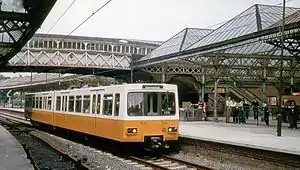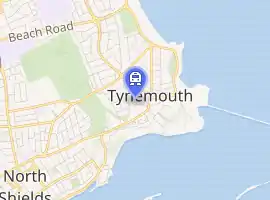Tynemouth Metro station
Tynemouth is a Tyne and Wear Metro station, serving Tynemouth in North Tyneside. It joined the network on 11 August 1980, following the opening of the first phase of the network, between Haymarket and Tynemouth via Four Lane Ends.
Tynemouth | |||||||||||
|---|---|---|---|---|---|---|---|---|---|---|---|
| Tyne and Wear Metro station | |||||||||||
 | |||||||||||
| Location | Tynemouth, North Tyneside England | ||||||||||
| Coordinates | 55°01′02″N 1°25′42″W | ||||||||||
| Grid reference | NZ368693 | ||||||||||
| Transit authority | Tyne and Wear Passenger Transport Executive | ||||||||||
| Platforms | 2 | ||||||||||
| Tracks | 2 | ||||||||||
| Construction | |||||||||||
| Parking | 71 spaces | ||||||||||
| Bicycle facilities |
| ||||||||||
| Disabled access | Step-free access to platform level | ||||||||||
| Other information | |||||||||||
| Station code | TYN | ||||||||||
| Fare zone | C | ||||||||||
| History | |||||||||||
| Original company | North Eastern Railway | ||||||||||
| Pre-grouping | North Eastern Railway | ||||||||||
| Post-grouping | |||||||||||
| Key dates | |||||||||||
| 7 July 1882 | Opened | ||||||||||
| 11 August 1980 | Joined the Tyne and Wear Metro network | ||||||||||
| Passengers | |||||||||||
| 2017/18 | 0.56 million[1] | ||||||||||
| Services | |||||||||||
| |||||||||||
| Location | |||||||||||

| |||||||||||
History
The station was originally opened on 7 July 1882 by the North Eastern Railway.[2] Designed by architect William Bell, the station was designated as a Grade II* listed building on 2 November 1978.[3]
Following a significant decline in the number of passengers using the North Eastern Railway's services in North Tyneside in the early 1900s, the line was electrified as part of the Tyneside Electrics network, using a 600 V DC third-rail system.[4]
Owing to falling passenger numbers, rising costs, and the need to renew life expired infrastructure and rolling stock, the Tyneside Electrics network was de-electrified and converted to diesel multiple unit operation in 1967.[5]
The station has remained in constant use since opening, with British Rail continuing to use the station's former bay platforms for services from Newcastle via Wallsend until the day before the first section of the Tyne and Wear Metro opened.
Tynemouth joined the Tyne and Wear Metro network on 11 August 1980, with the opening of the first phrase of the network between Haymarket and Tynemouth via Four Lane Ends. Prior to the introduction of through services to St James via Wallsend on 14 November 1982, all trains used the present platform 2.
Regeneration
In 2007, English Heritage placed the station on their Heritage at Risk Register.[6] The survey is used by national and local government, a wide range of individuals and heritage groups to establish the extent of risk and to help assess priorities for action and funding decisions.
Work on the £3.68 million regeneration project began in early 2011,[7] and was completed in the following year. On 2 July 2012, the station was officially reopened by Anne, Princess Royal,[8][9][10] and subsequently removed from the register.
Facilities
The station has two platforms, both of which have ticket machines (which accept cash, card and contactless payment), seating, next train audio and visual displays, timetable and information posters and an emergency help point.
There is step-free access to both platforms by road bridge, with platforms also linked by a pre-grouping wooden footbridge, which is similar in design to that at nearby Cullercoats.
The station has a pay and display car park, with 71 spaces. There is also cycle storage at the station, with 4 cycle pods and 5 Sheffield stands.[11]
Services
As of January 2021, the station is served by trains every 12–30 minutes, with additional trains at peak times. Trains are currently operating to a reduced timetable, owing to the COVID-19 pandemic.[11]
Rolling stock used: Class 994 Metrocar
Tynemouth Market
A weekly market is held at the station every Saturday and Sunday, which doubles as a farmers' market once a month. The Friends of Tynemouth Station also hold book fairs several times a year at the station.
See also
References
- "Tyne and Wear Metro usage figures 2017–18". Retrieved 21 August 2019.
- Hoole, Kenneth (1974). A Regional History of the Railways of Great Britain: Volume IV, The North East. Newton Abbot: David and Charles. p. 204. ISBN 978-0715364390.
- Historic England. "Tynemouth station buildings, canopies and footbridge (Grade II*) (1185168)". National Heritage List for England. Retrieved 27 December 2020.
- Hoole, Kenneth (1974). A Regional History of the Railways of Great Britain: Volume IV, The North East. Newton Abbot: David and Charles. p. 213. ISBN 978-0715364390.
- Young, Alan (1999). Suburban Railways of Tyneside. Martin Bairstow. p. 20. ISBN 978-1871944204.
- "At-risk buildings 'need millions'". BBC News. 24 July 2007. Retrieved 27 December 2020.
- "Tynemouth preserved". Nexus. 13 April 2011. Retrieved 28 December 2020.
- Wilson, Richard (2 July 2012). "The Princess Royal arrives at Tynemouth Metro station". ITV News. Retrieved 27 December 2020.
- Bell, Bethan (8 November 2018). "Historic England: The endangered buildings saved from ruin". BBC News. Retrieved 27 December 2020.
- Nugent, Helen (16 April 2012). "Tynemouth's wonderful welcome is back on the rails". The Guardian. Retrieved 27 December 2020.
- "Timetables and stations: Tynemouth". Tyne and Wear Passenger Transport Executive. Retrieved 2 January 2021.
External links
 Media related to Tynemouth Metro station at Wikimedia Commons
Media related to Tynemouth Metro station at Wikimedia Commons- Timetable and station information for Tynemouth